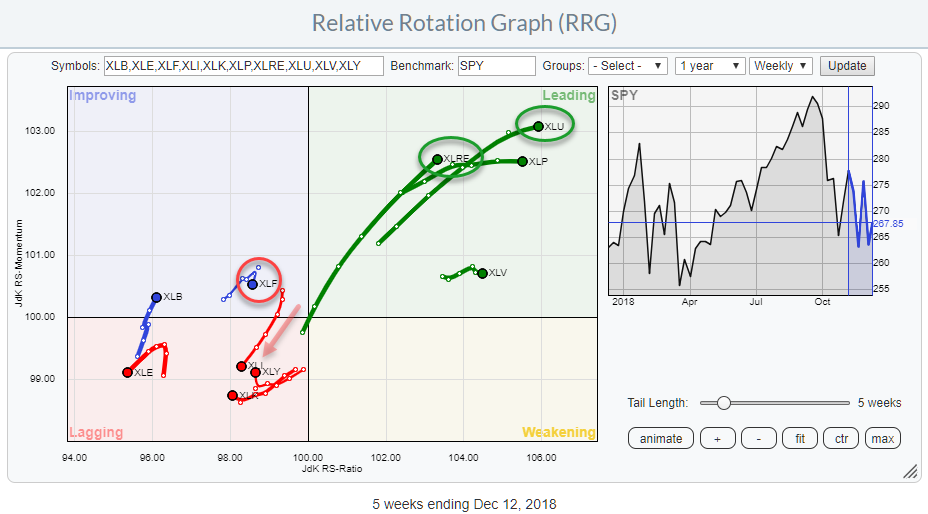 The market keeps throwing us curve balls on a daily basis. The Relative Rotation Graph above translates these curve balls into (sector-) rotational patterns.
The market keeps throwing us curve balls on a daily basis. The Relative Rotation Graph above translates these curve balls into (sector-) rotational patterns.
The weekly chart above shows continuing strength for Utilities and Real Estate as they continue to move higher on both axes of the RRG.
Staples and Healthcare are still comfortable inside the boundaries of the leading quadrant but lost a bit of their relative momentum which causes them to move more or less flat for now. There is nothing wrong with flat and higher on the JdK RS-Ratio scale! It means that the relative uptrend is intact and still moving higher but at a stable pace.
Defense
The weekly RRG is still screaming "defense". Utilities, Staples, Healthcare, and Real-Estate are all inside lagging and moving right, i.e. gaining relative strength versus the S&P 500. While Industrials, Technology, Discretionary, and Energy are inside the lagging quadrant and losing relative strength. Materials is inside the improving quadrant but far away to the left and with a very short tail, which makes a rotation towards leading very difficult at the moment.
The financial sector is also inside improving but sharply turned around on the weekly chart (for the week so far).
As the swings are so wide and big up-days are followed by big down-days I want to look at the daily rotations as they give a more granular insight.
I am especially interested in Utilities and Real-Estate that are in leading and Financials and Industrials which are in improving, but turning down again, and lagging on the weekly RRG.
Daily RRG
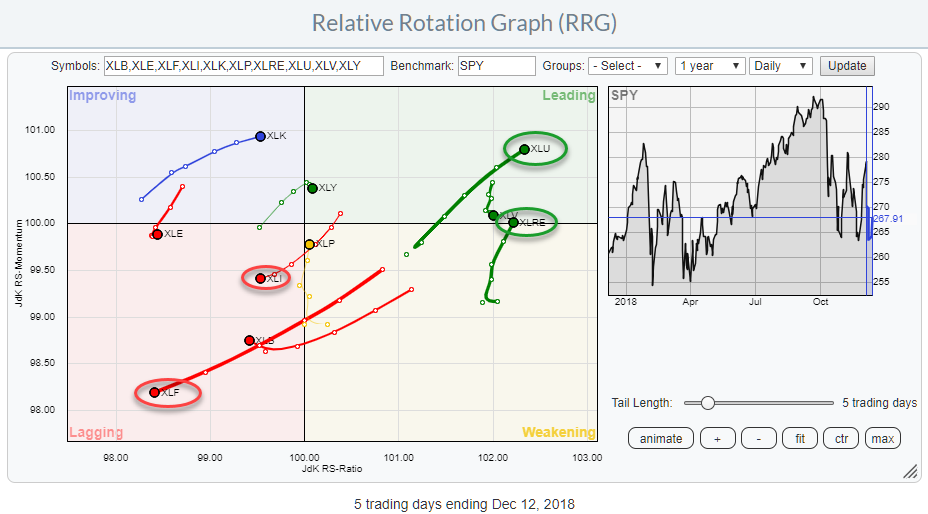 This daily Relative Rotation Graph shows Utilities and Real-Estate (far) to the right of the plot and inside the leading quadrant. Utilities is leading the rotation and returned into the leading quadrant 5 days ago after a short stint through weakening. Real Estate is now following that lead and returned inside the leading quadrant yesterday after moving through weakening for a few days.
This daily Relative Rotation Graph shows Utilities and Real-Estate (far) to the right of the plot and inside the leading quadrant. Utilities is leading the rotation and returned into the leading quadrant 5 days ago after a short stint through weakening. Real Estate is now following that lead and returned inside the leading quadrant yesterday after moving through weakening for a few days.
The bottom line for these rotations is that they are confirming the rotations for Utilities and Real-Estate on the weekly RRG.
Both utilities and Real-Estate seem ready for more outperformance in the weeks to come.
A similar picture can be painted at the left-hand side of the RRG.
On the weekly chart, Financials are inside the improving quadrant but turning sharply down this week. On the daily RRG has the longest tail of all sectors and moved rapidly from weakening into lagging over the past 5 trading days and is now the weakest sector on the daily time-frame.
The Industrials sector left the lagging quadrant on 7 Nov. and rotated through improving and weakening and returned back into the lagging quadrant last Monday and is now back in sync with the position and rotation on the weekly RRG.
In negative territory Financials and Industrials are now back in sync with their rotations on the weekly RRG and expected to continue their underperformance against the S&P 500 going forward.
Utilities
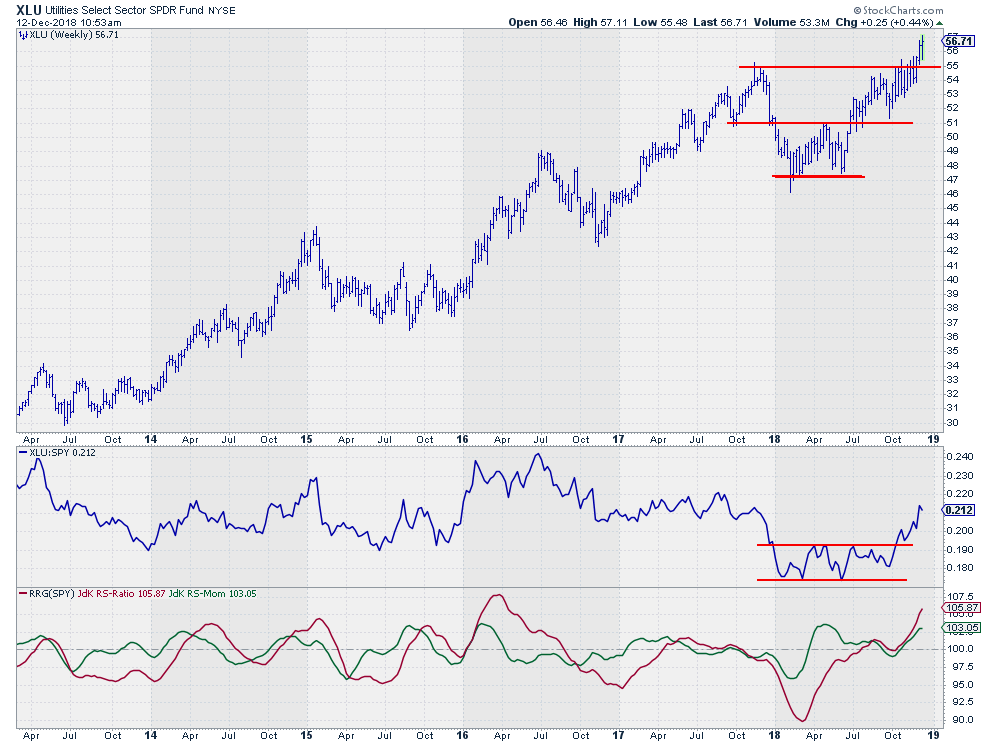 Relative Strength completed a turnaround from the falling trend that was in play since early 2016 for this sector. The upward break out of the consolidation between January and October triggered the acceleration in relative strength that is now powering the strong Rotation on the Relative Rotation Graph.
Relative Strength completed a turnaround from the falling trend that was in play since early 2016 for this sector. The upward break out of the consolidation between January and October triggered the acceleration in relative strength that is now powering the strong Rotation on the Relative Rotation Graph.
The upward break to new highs on the price chart is only adding to this positive outlook. The downside is well protected by the former resistance level near $ 55 which can now be expected to act as support in case of pull-backs.
Real-Estate
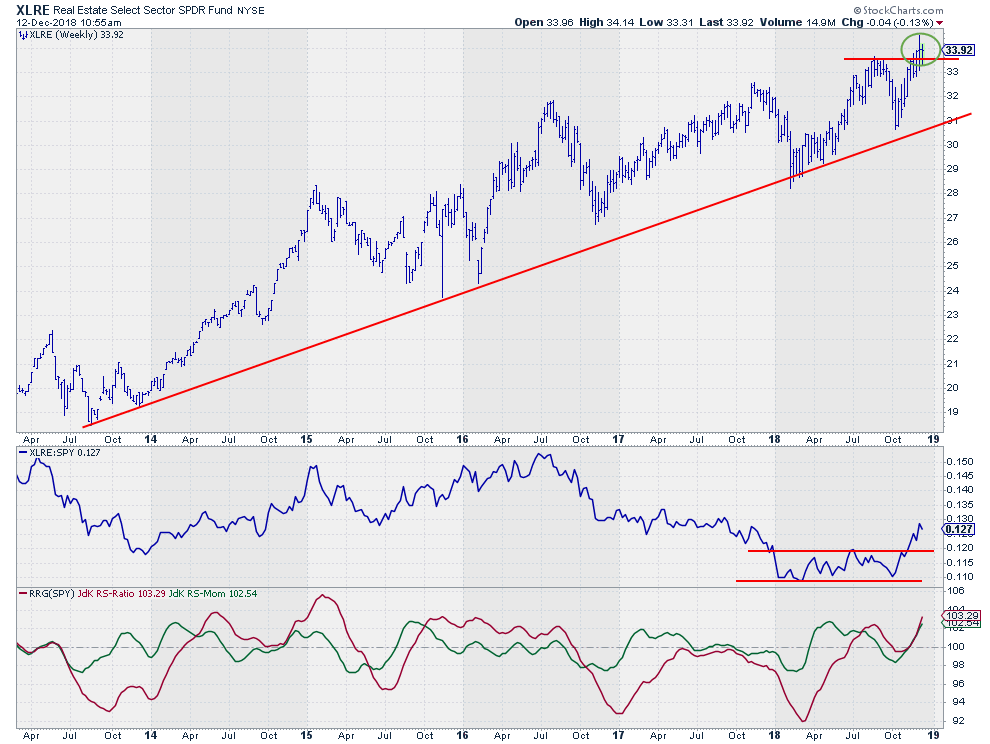 Similar to Utilities, the Real-Estate sector turned its downtrend, since mid-2016 around after breaking out of the consolidation period that characterized 2018 for this sector until recently.
Similar to Utilities, the Real-Estate sector turned its downtrend, since mid-2016 around after breaking out of the consolidation period that characterized 2018 for this sector until recently.
Here also the upward break to new highs in price is helping the improvement in relative strength.
The former resistance level at $ 33.50 should now limit any corrections.
Financials
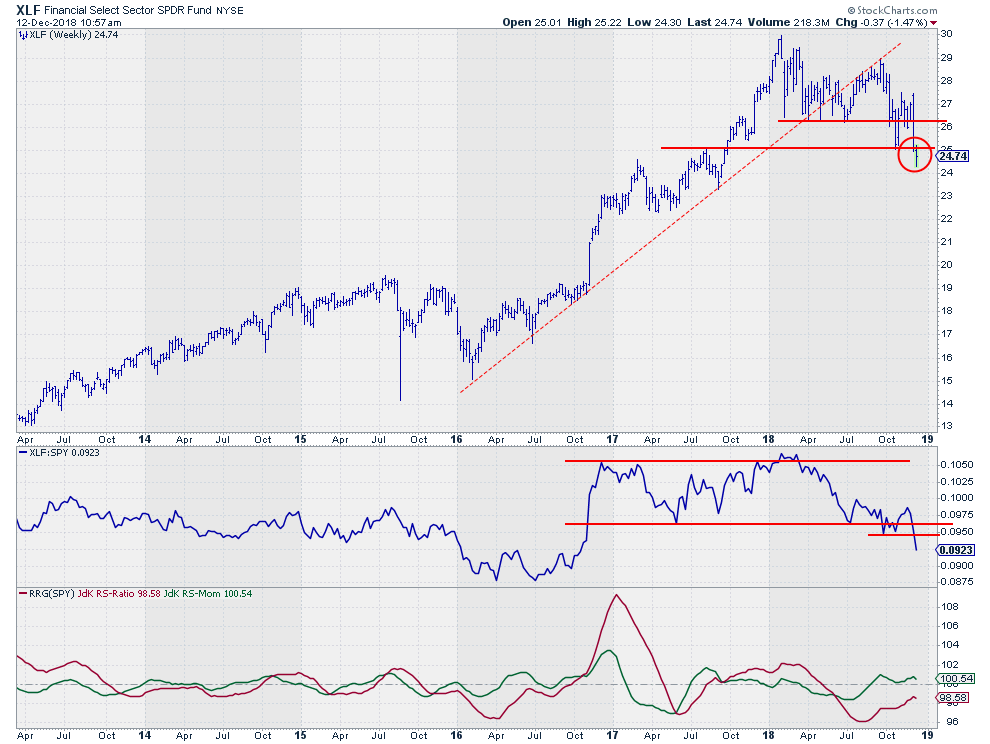 The picture for Financials continues to slide. In the past weeks, relative strength dropped below its previous lows, confirming the weakness against the S&P 500. For the RRG-Lines this means that the JdK RS-Momentum line will very likely not be able to hold up above the 100-level and cause XLF to rotate back into the lagging quadrant after only a very short period in improving.
The picture for Financials continues to slide. In the past weeks, relative strength dropped below its previous lows, confirming the weakness against the S&P 500. For the RRG-Lines this means that the JdK RS-Momentum line will very likely not be able to hold up above the 100-level and cause XLF to rotate back into the lagging quadrant after only a very short period in improving.
The price chart is supporting further weakness as the price is now breaking below its previous low on the weekly chart ($ 25). This opens up more downside price action towards the $22-23 area.
Industrials
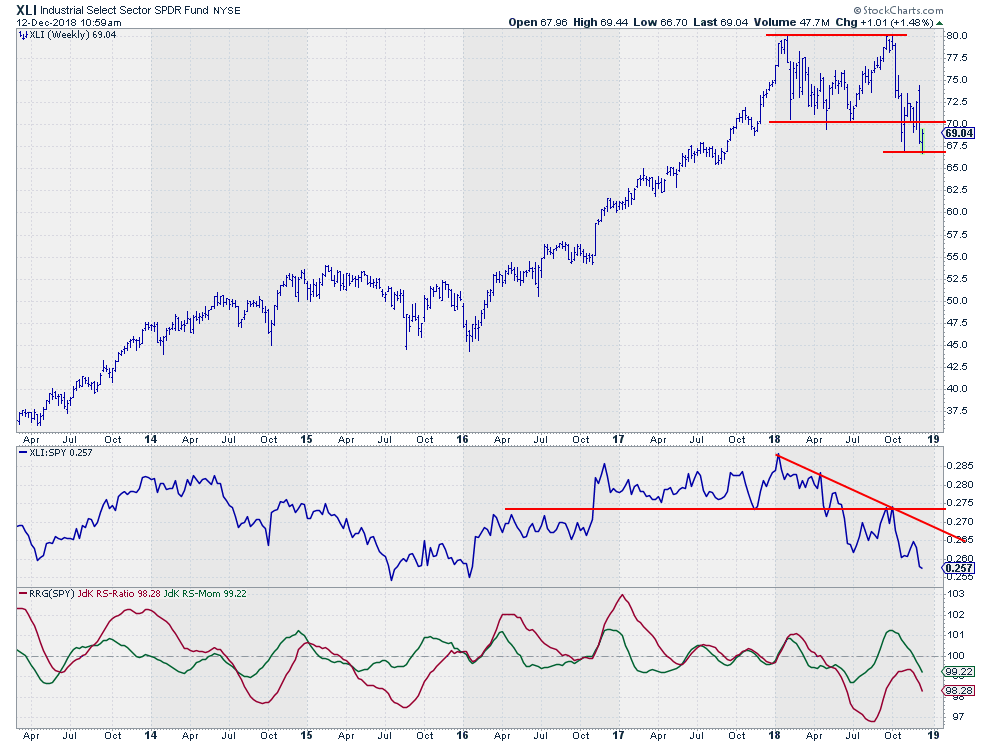 The RRG-Lines, for the Industrials sector, leave no doubt. Both are heading lower and the RS-Ratio line has formed a peak below 100 which is strong confirmation for the already existing downtrend. This is also visible in the raw RS-Line which is taking out.
The RRG-Lines, for the Industrials sector, leave no doubt. Both are heading lower and the RS-Ratio line has formed a peak below 100 which is strong confirmation for the already existing downtrend. This is also visible in the raw RS-Line which is taking out.
The result is s strong push, back, into the lagging quadrant, suggesting a further underperformance in coming weeks/months.
Let me know what you think of this usage of RRG in the comments below. If you would like to receive a notification when a new RRG blog article is published, simply "Subscribe" with your email address using the form below.
Julius de Kempenaer | RRG Research
RRG, Relative Rotation Graphs, JdK RS-Ratio, and JdK RS-Momentum are registered TradeMarks ®; of RRG Research
Follow RRG Research on social media:
If you want to discuss RRG with me on SCAN, please use my handle Julius_RRG so that I will get a notification.
